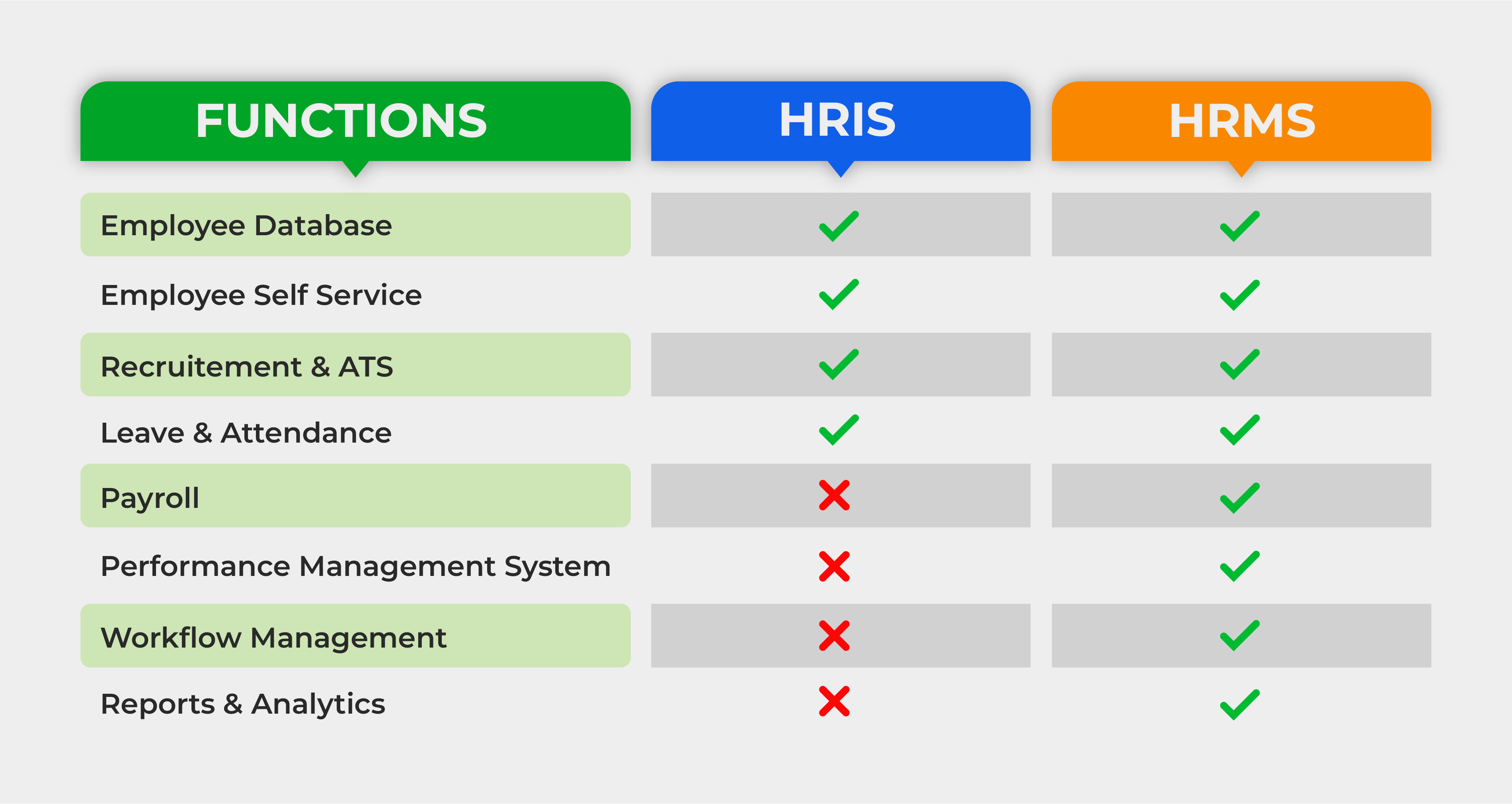“HRIS or HRMS? What’s the difference?”
We’re sure you would have thought about this at least once. And if not, it is high time you be aware of these terms and their meaning as you would not want to be ripped off in the name of such fancy words.
In this blog, we will be talking about HRIS and HRMS. The differences between them and which one should you opt for!

HRIS
HRIS in comparison to HRMS is a narrower term. A Human Resource Information System, as the name suggests, helps you manage your workforce better. HRIS functions majorly relate to the human resources of the organisation. Following are the major services an HRIS offers:
– Employee Database
Employee database means employees’ personal, professional and official information present in the system. The onboarding process creates the employee database. Employee database is also frequently referred to as employee master. All the necessary documents like ID, Bank Details, etc. are collected at the time of onboarding. All this information is then used to create an employee master.
– Employee Self Service
Employee Self Service (ESS) dismisses the need of an employee to go to the HR. ESS is a portal service which allows employees to be less dependent on the HR. It allows the HR manager to do more complex tasks like managing the workforce, workflow, etc.
ESSalso helps in maintaining a friendly work environment in your organisation. You can read What is Employee Self Service and how is it beneficial for your organisation? to know more about ESS.
– Recruitment & ATS
Next up, a Human Resource Information System takes care of your recruitment needs. Along with recruitment, a good HRIS offers a Applicant Tracking System as well. Depending upon the solution provider these can be full fledged recruitment solutions or not.
– Leave & Attendance
A good HRIS also offers you the ease of automating attendance and leave management. HRIS offers you the following features to boost leave and attendance management efficiency:
- Leave Planner
- Attendance Calendar
- Biometric Integration and/or Facial Recognition
- Geo-tagging and Geo-fencing
and much more! (These features may vary depending upon the solution provider)
-
HRMS
Now talking about HRMS, it is a much wider term and is usually used synonymously with HRIS. While HRIS relates to the workforce and human resources, an HRMS deals with everything an HR has to do. A Human Resource Management System offers automated solutions to all the major processes of an organisation. HRMS majorly offers the following services:
– HRIS
As stated above, HRMS is the wider term and it offers every service offered by an HRIS. In fact, HRMS has an edge over traditional HRIS as it is usually modular. This means that the services can be separated into modules and can be purchased when required. This makes HRMS the superior choice as it grows with you while not making a hole in your pocket.
– Payroll
Okay, now talking outside HRIS, The most important thing an HRMS offers you is Payroll Management! Payroll management with an HRMS is absolute delight as it is usually integrated with time and attendance, payroll processing takes just a few clicks. To know more about payroll, you can read 9 Essential features a payroll must offer.
– Performance Management System
PMS is a tool that helps the HR track the performance of individual employees. It automates tracking the progress of an employee and provides the manager employee performance reports. This would then help the higher level management track the performance.
– Workflow Management
HRMS also lets you plan and create a workflow chart to streamline the workflow. This helps the employees get a better idea of the vision of the management and eliminates confusion. Alongside the planning and setup, an HRMS also allows you to monitor the workflow and make necessary changes whenever required.
 – Reports & Analytics
– Reports & Analytics
It’s reporting time! From candidate interview reports to the full and final settlement report, an HRMS helps you summarise everything in a report. You can even generate detailed reports for reference purposes. Having quick access to your reports and analytics greatly boosts your productivity.
HRMS is not limited to only these features though. At least not Spine HR Suite. Spine HR Suite has 18 different modules to pick and choose from. Even a chatbot who acts as your own virtual assistant- Spina! You can learn more about Spine HR Suite here.
In conclusion, it is much better to go for an HRMS as it is everything that an HRIS is and much more. But HRMS tends to lean on the expensive side for smaller organisations. Spine HR Suite tackles this problem by offering HRIS as a module! HRIS is paired with payroll so that all the basic activities of an HR can be automated at a relatively lower cost.
